
Recommended Backpack Volumes
How much volume should you get in a daypack, weekend backpack, multi-day backpack, or expedition backpack? Here are some volume guidelines and advice so you can start shopping for backpacks in the appropriate size range.
Hiking Backpack Volume Guide
Hiking Daypack Sizes (1/2 day to full-day hikes)
Most daypacks range from 15 liters to 35 liters on the high-end. While a smaller-sized 15-25 liter backpack is usually sufficient for 1/2 day hikes, you’ll want a larger pack in the 25-30 liter range for all-day hikes or winter so you can carry extra water, food, clothing, and the 10 essentials. Many backpacks under 25 liters in size will not have hipbelts and they’re really not necessary if you’re carrying less 15-20 pounds of food, water, and clothing. Once you get above 25 liters in pack volume, though you should be looking at backpacks with hipbelts, since the weight will sit on your hips and not your shoulders, making it much easier to carry.
The daypack category also includes hydration packs which can be a good option. Just make sure that you have sufficient volume to carry your extra clothing and gear.
If you’re a winter day hiker and snowshoer, I’d recommend sizing up to a 35-40 liter backpack capable of carrying snowshoes, microspikes, water, food and bulkier insulated clothing. You need a beefier backpack than a small daypack to carry snowshoes (which weigh 5 lbs alone) when they’re not needed.
Recommended Hiking Daypacks
| Men's Model | Sizing | Women's Model |
|---|---|---|
| Osprey Talon 22 | Adjustable Torso | Osprey Tempest 20 |
| REI Flash 18 | Fixed Length | REI Flash 18 |
| TNF Borealis 28 | Fixed Length | TNF Borealis 27 |
| Osprey Stratos 24 | Adjustable Torso | Osprey Sirrus 24 |
| Deuter Speed Lite 21 | Fixed Length | Deuter Speed Lite 21 |
| REI Trail 25 | Fixed Length | REI Trail 25 |
| Gregory Zulu 30 | Adjustable Torso | Gregory Jade 28 |
| Gregory Nano 22 H2O Pack | Fixed Length | Gregory Nano 22 H2O Pack |
| Deuter Trail 30 | Fixed Length | Deuter Trail 28 SL |
| Mystery Ranch Scree 33 | Adjustable Torso | Mystery Ranch Scree 33 |
Weekend Backpacks (1-3 Nights)
You can’t use most daypacks for overnight and weekend backpacking trips because you need to carry a lot more gear, such as a sleeping bag/quilt, sleeping pad, sleeping clothes, tent/shelter/hammock, stove, cooking pot and utensils, and more food.
All this extra stuff requires more space, even if you take a minimalist or ultralight approach to gearing up. For a 1-3 night weekend trip, the sweet spot is going to be a backpack with 40 to 50 liters of volume.
Recommended Multi-day Backpacks
| Make / Model | Weight | Fabric |
|---|---|---|
| Zpacks Arc Haul 60L | 20.9 oz / 593g | Ultra 200 |
| Hyperlite Mountain Gear Southwest 55 | 34.9 oz / 989g | Dyneema DCF |
| Granite Gear Crown 3 60L | 32.6 oz / 1040g | Robic Nylon |
| Osprey Exos Pro 55 | 34.6 oz / 981g | UHMWPE Nylon Ripstop |
| ULA Circuit 68L | 37.3 oz / 1038g | Robic Nylon |
| Gossamer Gear Mariposa 60L | 34.2 oz / 968g | Robic Nylon |
| REI Flash 55L | 45 oz / 1276g | Robic Nylon |
| Gregory Focal 58 | 41.3 oz / 1171g | Robic Nylon |
| SWD UL Long Haul 50 | 30.2 oz / 856g | Ultra 200 |
| Durston Kakwa 55 | 31 oz / 880g | Ultra 200 |
Multi-day Backpacks (3-5 Nights)
The biggest difference between shorter weekend and multi-day backpacking trips is the need to carry more food and possibly a bit more technical gear, depending on the kind of activities or climate you’ll be hiking in.
For multi-day trips, you’re going to want 50 to 70 liters of backpack volume, but if you go ultralight or use compressible gear that doesn’t take up a lot of space, you might be able to get by with less than that.
Expedition Backpacks (5+ Nights)
Expedition backpacks are the behemoths of the backpacking world and range in size from 80 liters up to 110 liters or more. They’re designed to hold a mammoth amount of food and gear, usually for professionally guided mountaineering trips. If you’re going on a trip like this, it’s probably worth asking your guide for backpack recommendations. They may also have gear that you can rent since expedition backpacks can be quite expensive.
How Backpack Volume is Measured
Most major backpack manufacturers measure the volume of their backpacks by adding up the total volume of the closed storage on their packs, including the main compartment, pockets, and hip belt pockets that can be closed or zippered shut. However, many smaller manufacturers use a different method and include open pockets like side water bottle pockets or rear mesh pockets in addition to the closed storage. This can make weight-to-volume comparisons a little misleading when comparing packs from different manufacturers When in doubt, contact the manufacturer to ask what method they use to measure backpack volume.
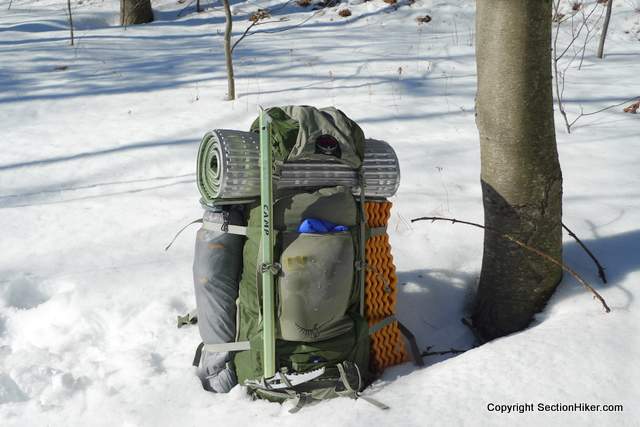
External Attachments
If you plan to carry a lot of bulky gear, you don’t have to carry all of it inside the closed storage of a backpack. Bulky sleeping pads, tents, rain gear, snowshoes, and water bottles are commonly stuffed into exterior pockets or attached to the sides, back or bottom of a backpack with webbing or compression straps. This lets you use the same backpack for medium and longer trips, without having to buy a second larger pack to carry your extra gear.
 SectionHiker.com Backpacking Gear Reviews and FAQs
SectionHiker.com Backpacking Gear Reviews and FAQs 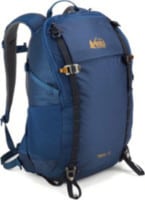
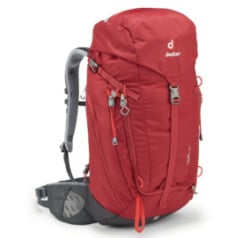

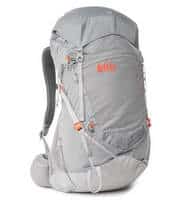

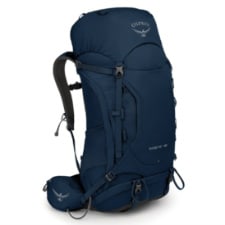

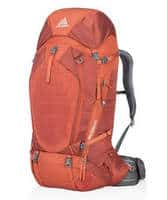

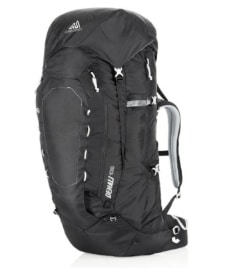
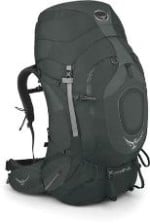
It kind of depends on what, when, and where you plan to do your overnight (depends on weather, remoteness, hostile wildlife, insects). For assuming a temperate 3 season setting, if you brought a 1 person tent and a 40 degree sleeping bag, a stove, food, bear bag, water filter, and sleeping baselayers (which I highly recommend) that will add about 15-25 liters of gear to your backpack. If you can shrink your entire contents to 30 go for it. Personally, I usually fill about 35 liters of a 40L pack for every 1 night trip I take. But the night 2 and 3 loads only consist of extra food. That’s why there’s such a big jump on night 1.
Very helpful, thankyou!
They all look different depending on the backpack make and model. But if it helps, it’s slightly larger than a paper shopping bag in terms of volume.
35 liters is roughly about 2500cubic inches which is roughly about 1.5 cubic feet or about 9 US gallons using very approximate conversions.
Grocery bags actually vary quite a lot it seems but the ones I have and think are typical are about 1200 cui which is about 20 liters or 5 US gallons.
I was actually surprised how much gear I can get in my REI Traverse 35 which is nominally a 37 liter pack. I measured it and that is the size of the main compartment with the draw string loose.
Here is the list…
Main Bag…from bottom to top
Kelty Light year 20 sleeping bag in compression sack
Thermarest Xlite regular
Inflatable pillow
OR Transcendent hooded puffy
Sleepwear and Spare clothing Stuffsack…Merino Half zip, long underwear, briefs, wool boot socks
BA TigerWall UL2 Tent (poles, stakes and footprint in separate bags…poles are vertical down one corner)
Warm clothing Stuffsack…beanie and insulated gloves
Soto Amicus cookset stove combo
Back Zip Pocket…
Rain Jacket and Pants
Trowel+Bidet etc.
Brain…
Sawyer Squeeze Filter and CNOC Vectro
First Aid Kit
Repair Kit
Headlamp
Buff
etc.
Hip belt pockets…
Bug net
Trekking pole tips
Lip grease
Small tube of sunscreen
Outside
Xero sandals (for camp/river crossings) These could go in the back “mesh” pouch but I strapped them in the “lifter”)
That lot weighs 18.2# with the pack and is a fairly impressive list for a “day pack”. While some of that gear is quite light weight and low volume, some of it isn’t. I didn’t use either the back or side mesh pockets and there was a bit of room left inside for food for a day or so.
The pack was obviously a bit overstuffed so may not be that comfortable to carry like that for very long. The top end of the mesh back was touching the bag. I would definitely trim the list for actual 1-3 night use…and probably only consider using it for summer when bad weather is unlikely.
I suspect that REI does not include open pockets in their volume calculation. Most major brands don’t. There’s actually an industry standard for this, which small manufacturers ignore or don’t know about. In addition, if you have the large size, the volume is actually 37 liters.
I think you are right about that based on my measurement although synch’ed up the main bag measures out at more like 32L. REI also gives a rather odd dimensional size of 27 x 12 x 11 which is ~3500cui or ~57L and it is unclear what that is supposed to indicate… REI don’t actually list the Traverse 35 as a day pack although various reviewers do and I bought it with that in mind. I did think it might be a bit overkill for that purpose but having suffered from floppy light weight day sacks that tire you out carrying a liter of water and a jacket if you go more than about an hour with them, I thought it was worth a try.
I regularly carry a 38L pack for day hikes in the mountains. Of course, it snows year-round here and I often bring a few pounds of fly fishing gear with me.
Ok, so we are planning a week hiking but will be staying in B&B, pubs and hostels overnight. All that I’ve read accommodates camping equipment and food which we’ll not be taking (other than snacks and possibly mid-day picnics). How would that affect the pack sizes you are recommending?
Sounds like you only need day packs.
Yes, but most of the people who are searching for an answer to this question are probably not ultralight backpackers or trust fund babies. You can eventually reduce the volume and weight of your gear if you really put your mind to it and you’re willing to pay the big bucks (or just hike in nice weather). The rest of us like to carry a few extra bulky comforts and don’t do 30 day trips!
Also there is no way you are carrying 30 days of food in a 38 liter pack so probably you are really doing 10 3 day trips back to back.
But we were supposed to be impressed! Darn.
Most of the time I carry a 38L daypack because I take long hikes in remote areas where it would be impossible for rescuers to reach me before nightfall. That means carrying enough insulation, food, and water to survive the night if it gets cold. It also depends on where you go and what your goals are. Saying you don’t need a 35L pack is ridiculous if you don’t explain where you go and what you do more fully. While many under-equipped hikers get home safely without incident (no map, no headlamp, food, water, or insulation), you get to read about the ones that don’t. Don’t be that guy. I’m not saying you need to carry a huge amount of stuff, but being self sufficient is important I think.
Is it possible to modify the straps on a floating lid such as adding more length, or adding a new strap entirely?
It would require sewing.
Hi I walked from Kathmandu to base camp in 2 weeks 40 l / 45 l more than enough if you’re not camping that is no tent or roll mat .you can stay in tea lodges and they feed you for next to nothing and you can carry snacks which you can buy for cheap as you go along obviously there is no shortage of water and something bulky can always be strapped out side if need be underclothes don’t take up much space and if you want to carry food there’s still enough space